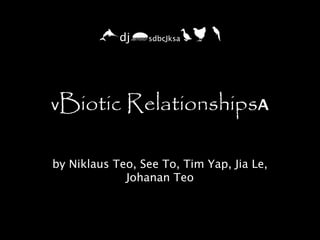
Biotic relationship - Group 3
- 1. ,djfsdbcJksadh k vBiotic RelationshipsA by Niklaus Teo, See To, Tim Yap, Jia Le, Johanan Teo
- 2. Predator-Prey AG Definition of Predator-Prey Relationship: — The interaction of two organisms in which one of them is the predator and captures/feeds on the other organism know as the prey. — Predation can be also know as population control seen in the right image — It can be presented simply in the form of food chain/web. Graph Showing Population Control By The Examples : Predator - Prey Relationship 1) Eagle (Predator) & Rabbit (Prey) a 6 Red Fox (Predator) Feeding On A Hare (Prey), taken 2)Cheetah (Predator) & Zebra (Prey) from http:// www.personal.ps C u.edu/euw122/ PHYS_527/ r HWK_2/pic.jpg Done by Johanan, information taken from http://www.globalchange.umich.edu/globalchange1/current/lectures/predation/predation.html
- 3. Mutualism l f Definition of Mutualism: — Positive reciprocal relationship between two species for survival — Reasons - Food, shelter, defense, transport, pollination, nutrition etc. — Types - Symbiotic relationship (obligate relationship), Non-symbiotic (in time of need) Examples: The crocodile lets the plover clean its teeth. 1) The Egyptian plover removes and eats meat stuck in between the crocodile’s teeth and feeds parasites off its tongue, getting a meal from the crocodile and giving it a dental cleanup. Clownfish are covered with slimy mucus that protects them from the anemone. 2) Clown fish get protection by dwelling in the Ritteri sea anemones and in return cleans food leftovers and keeps the anemone well circulated by fanning their fins. Done by Jia Le, information taken from http://www.pz.harvard.edu/ucp/curriculum/ ecosystems/s5_res_symbiosis.pdf , http://tolweb.org/treehouses/? treehouse_id=3390
- 4. Commensalism ix Definition of Commensalism: — One organism benefits but the other is neutral (there is no harm or benefit) — The two animals are called commensals. — Commensalism is a type of symbiosis. The Remora shark is hitching a ride on Examples: another shark as seen in the picture. This is an example of commensalism(http:// thelostjacket.com/community/parasitic- marketing 1)While feeding, cattle kick up insects, which the egrets quickly eat. The birds get a good meal, but the cattle receive no benefit or harm. The Egrets are standing on the cattle while it waits for their chance to feed on insects (http:// 2)Remora sharks are endowed with an adhesive disk on the dorsal www.game-reserve.com/) surface of their heads. They use this adhesive disk to “hitch a ride” on larger animals, usually whales, which tend to be sloppy eaters. When food floats away from the whale’s mouth, the remora can unhitch itself and collect the scraps of food floating by. Done by Niklaus, information taken from http://www.nearctica.com/ecology/pops/commens.htm http://www.cbu.edu/~seisen/ExamplesOfCommensalism.htm
- 5. Definition of Parasitism: Parasitism VS —The parasite benefits while the host suffers. —Organism that lives on or within another organism>> Within the host :Endoparasites Outside the host : Ectoparasites —Organisms that live by drawing food from a host organism —Parasitosis refers forms of parasitism that injure the host Image to the left shows the flea, a common parasite among animals like Examples: cats and dogs http:// 1) A type of parasitic wasp lays its eggs in another host insect, commonly a static.howstuffworks.com/gif/flea-1.jpg caterpillar 2) Tapeworms may also invade dogs or cats if they accidentally swallow fleas during grooming 3) Lamprey, a type of parasitic fish, sucks the blood of other fishes 4)When a human eats undercooked meat or fish, they may get invaded by tapeworms, which robs the human of the vitamin B12. Its excrement is also toxic and might be harmful Image left shows a possible way of -Human parasites :Hookworm, Tapeworm, Heartworm, Roundworm how parasites get into the human body http://altered-states.net/barry/ update200/parasite_chart.gif Done by See To, information taken from http://kids.britannica.com/comptons/article-206156/parasite
- 6. Symbiosis among Plants $V An example of symbiosis among plants is the Mistletoe. It performs a symbiotic relationship with trees (almost any deciduous type) in which the mistletoe is the parasite and the tree is the host. In this picture, the mistletoe is shown growing on a tree branch. Anyone want to kiss under it? Taken from http://www.treeweaverarborist.com/ How the mistletoe does it: blog/?p=65 — One of the familiar sticky berries of the mistletoe comes into contact with the bark of a tree - generally through the agency of birds. — After a few days it sends forth a thread-like root, flattened at the extremity like the proboscis of a fly. — This pierces the bark and roots itself firmly in the growing wood, from which it has the power of selecting and appropriating to its own use, such juices as are fitted for its sustenance. —The mistletoe at no period derives nourishment from the soil, or from decayed bark, like some of the fungi do - all its nourishment is obtained from its host. The root becomes Done by Tim, information taken from http://botanical.com/botanical/mgmh/m/mistle40.html woody and thick.
- 7. AsDty6 CVXBZNAMS>|}{P@)(*&^ 2dfjblqo2nvksrAQ!@$ QWEYUFSghjk67B jqv35sogp The End x{cvbmgklAKS asdfghjoA,./=-6 qwertycvbn,/234567890hgdZXCVBMAF
Editor's Notes
- \n
- \n
- \n
- \n
- \n
- \n
- \n